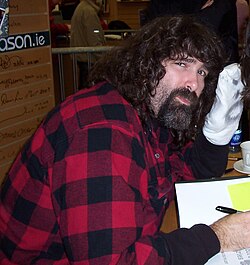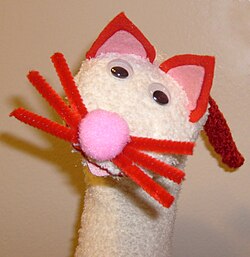Difference between revisions of "AY Honors/Puppetry/Answer Key"
m (533 revisions from w:Sock puppet: tranwiki merge of w:Sock puppet to AY Honor Puppetry) |
|||
| Line 1: | Line 1: | ||
| − | {{ | + | {{otheruses4|cloth hand puppets}}<!-- Before re-adding self-ref link to WP:SOCK, please discuss on talk page --> |
| + | A '''sock puppet''' is a [[puppet]] made from a [[sock]] (or similar garment). When the manipulator fits a hand into the closed end of the sock, the puppet can be seemingly made to "talk". The puppet's mouth is formed by the region between the sock's heel and toe, with the puppeteer's thumb forming a jaw. At a minimum the shape of the hand will instantly form the shape of a mouth, but sometimes the mouth is padded by putting in a fairly hard piece of felt (often with a tongue glued inside). | ||
| + | [[Image:Sockcat.jpg|thumb|200px|Sock puppet]] | ||
| + | The sock is stretched out fully so that it is long enough to cover the puppeteer's wrist and part of the arm. Often, but not always, the puppeteer will hide behind a stand and raise up his or her hand above the stand so that only the puppet is visible. Many sock puppeteers, however, stand in full view along with their puppets and will hold conversations with their own sock puppets, using [[ventriloquism]]. | ||
| − | == | + | ==Composition== |
| − | |||
| − | + | Sock puppets can be made from socks or [[stocking]]s of any colour. Worn-out socks may be used, although socks that are too tattered may fall apart during performance, but socks are usually bought brand-new from the store in order to make sock puppets. Various additions can be glued on in order to give the sock a personality. Streamers and felt strings are popularly glued on for hair. Buttons are sewn on or [[Googly eyes]] (obtained from craft or fabric stores) are glued on for the puppet's eyes. Sometimes clothes can be added, but this is not frequently seen. | |
| − | |||
| − | |||
| − | |||
| − | |||
| − | |||
| − | |||
| − | |||
| − | |||
| − | |||
| − | |||
| − | |||
| − | Sock puppets can be | + | ==Uses== |
| + | Sock puppets are often used for the education and entertainment of children. They can be used in often elaborate puppet shows or children's plays, much as [[marionette]]s would be used. The process of making sock puppets is popularly taught as a creative activity in elementary schools. Many schools teach children to make sock puppets and then have the children put on shows or plays for the whole school with them, sometimes with all the sock puppets singing. | ||
| − | + | Sock puppets also appear in children's television shows where they can be used alone on the puppeteer's hand, without a complex stage or show. Two [[orange (colour)|orange]] sock puppets named "Fu" and "Fara" are used in teaching German children how to read. In the United States, sock puppeteer [[Shari Lewis]] was well known for her television show ''[[Lamb Chop's Play-Along]]'' featuring the sock puppets Lamb Chop, Charlie Horse, and Hush Puppy. | |
| − | + | Sock puppets have also been used in television programming aimed at adults. The 1990s saw the introduction of the [[Ed the Sock]] character on the [[MuchMusic]] video network, and the ''[[Sifl and Olly]]'' show on the [[MTV]] music network. Both of these were aimed at teenagers and young adults. Sock puppets have also appeared in [[advertising]] geared towards adults. During the late 1990s, the [[ecommerce]] company [[Pets.com]] used a "spokespuppet" in its advertising to much critical acclaim.<ref>[http://www.internetworld.com/magazine.php?inc=121500/12.15.00fastforward2.html Internet World Magazine :: Internet World<!-- Bot generated title -->]</ref> | |
| − | |||
| − | |||
| − | + | [[Image:Mick Foley and Socko.jpg|thumb|200px|Pro Wrestler [[Mick Foley]] and his accomplice, Mr. Socko.]]Professional wrestler [[Mick Foley]] has long used a sock puppet by the name of [[Mr. Socko (professional wrestling)|Mr. Socko]] as an aid in his finishing maneuver, a nerve hold called the Mandible Claw (or Socko Claw), which is usually preceded by Foley theatrically pulling the sock from somewhere on his person. On [[World Wrestling Entertainment]]'s [[Raw]] program, this has traditionally been a cue for commentator [[Jerry Lawler]] to complain about "that stinking, sweaty sock!" Mr. Socko has often served as a sidekick for Foley's [[Mankind]] character, having been introduced to the world during a skit on WWE television as a means of "cheering up" WWE owner [[Vince McMahon]], who had just been beaten by nemesis [[Stone Cold Steve Austin]]. The sock puppet unexpectedly became a hit with wrestling fans, garnering chants from a crowd of 10,000 plus at the following week's program. | |
| − | |||
| − | == | + | ==References== |
| − | + | {{reflist}} | |
| − | |||
| − | |||
| − | |||
| − | |||
| − | |||
| − | |||
| − | |||
| − | |||
| − | |||
| − | |||
| − | |||
| − | + | {{Commons+cat|Sock puppet|Sock puppets}} | |
| − | |||
| − | |||
| − | |||
| − | |||
| − | |||
| − | |||
| − | |||
| − | |||
| − | |||
| − | |||
| − | |||
| − | |||
| − | |||
| − | |||
| − | |||
| − | + | [[Category:Puppets]] | |
| + | [[Category:Socks]] | ||
| + | [[Category:Stuffed toys]] | ||
| − | [[ | + | [[ar:دمية جورب]] |
| + | [[bs:Čaraparko]] | ||
| + | [[de:Handpuppe]] | ||
| + | [[eo:Gantpupo]] | ||
| + | [[hr:Čarapko]] | ||
| + | [[ta:காலுறை பொம்மை]] | ||
| + | [[nl:Sokpop]] | ||
| + | [[ja:ソックパペット]] | ||
| + | [[no:Sokkedukke]] | ||
| + | [[simple:Sock puppet]] | ||
Revision as of 03:10, 25 July 2009
Template:Otheruses4 A sock puppet is a puppet made from a sock (or similar garment). When the manipulator fits a hand into the closed end of the sock, the puppet can be seemingly made to "talk". The puppet's mouth is formed by the region between the sock's heel and toe, with the puppeteer's thumb forming a jaw. At a minimum the shape of the hand will instantly form the shape of a mouth, but sometimes the mouth is padded by putting in a fairly hard piece of felt (often with a tongue glued inside).
The sock is stretched out fully so that it is long enough to cover the puppeteer's wrist and part of the arm. Often, but not always, the puppeteer will hide behind a stand and raise up his or her hand above the stand so that only the puppet is visible. Many sock puppeteers, however, stand in full view along with their puppets and will hold conversations with their own sock puppets, using ventriloquism.
Composition
Sock puppets can be made from socks or stockings of any colour. Worn-out socks may be used, although socks that are too tattered may fall apart during performance, but socks are usually bought brand-new from the store in order to make sock puppets. Various additions can be glued on in order to give the sock a personality. Streamers and felt strings are popularly glued on for hair. Buttons are sewn on or Googly eyes (obtained from craft or fabric stores) are glued on for the puppet's eyes. Sometimes clothes can be added, but this is not frequently seen.
Uses
Sock puppets are often used for the education and entertainment of children. They can be used in often elaborate puppet shows or children's plays, much as marionettes would be used. The process of making sock puppets is popularly taught as a creative activity in elementary schools. Many schools teach children to make sock puppets and then have the children put on shows or plays for the whole school with them, sometimes with all the sock puppets singing.
Sock puppets also appear in children's television shows where they can be used alone on the puppeteer's hand, without a complex stage or show. Two orange sock puppets named "Fu" and "Fara" are used in teaching German children how to read. In the United States, sock puppeteer Shari Lewis was well known for her television show Lamb Chop's Play-Along featuring the sock puppets Lamb Chop, Charlie Horse, and Hush Puppy.
Sock puppets have also been used in television programming aimed at adults. The 1990s saw the introduction of the Ed the Sock character on the MuchMusic video network, and the Sifl and Olly show on the MTV music network. Both of these were aimed at teenagers and young adults. Sock puppets have also appeared in advertising geared towards adults. During the late 1990s, the ecommerce company Pets.com used a "spokespuppet" in its advertising to much critical acclaim.&

Professional wrestler Mick Foley has long used a sock puppet by the name of Mr. Socko as an aid in his finishing maneuver, a nerve hold called the Mandible Claw (or Socko Claw), which is usually preceded by Foley theatrically pulling the sock from somewhere on his person. On World Wrestling Entertainment's Raw program, this has traditionally been a cue for commentator Jerry Lawler to complain about "that stinking, sweaty sock!" Mr. Socko has often served as a sidekick for Foley's Mankind character, having been introduced to the world during a skit on WWE television as a means of "cheering up" WWE owner Vince McMahon, who had just been beaten by nemesis Stone Cold Steve Austin. The sock puppet unexpectedly became a hit with wrestling fans, garnering chants from a crowd of 10,000 plus at the following week's program.
References
ar:دمية جورب bs:Čaraparko de:Handpuppe eo:Gantpupo hr:Čarapko ta:காலுறை பொம்மை nl:Sokpop ja:ソックパペット no:Sokkedukke simple:Sock puppet

